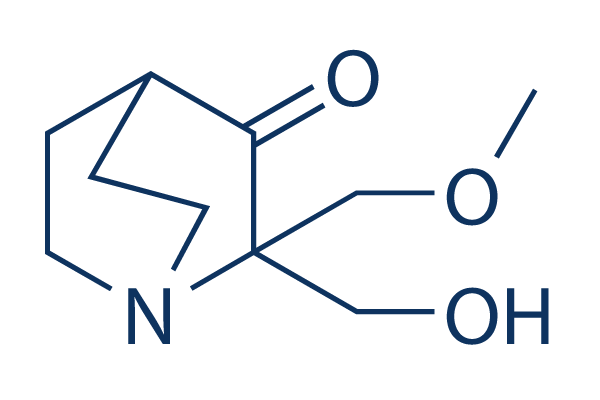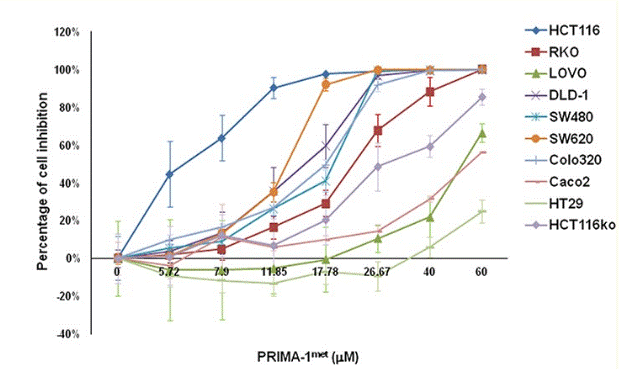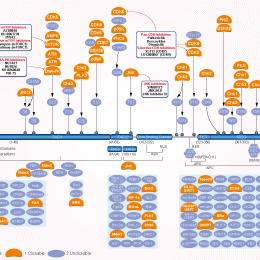
- Bioactive Compounds
- By Signaling Pathways
- PI3K/Akt/mTOR
- Epigenetics
- Methylation
- Immunology & Inflammation
- Protein Tyrosine Kinase
- Angiogenesis
- Apoptosis
- Autophagy
- ER stress & UPR
- JAK/STAT
- MAPK
- Cytoskeletal Signaling
- Cell Cycle
- TGF-beta/Smad
- DNA Damage/DNA Repair
- Compound Libraries
- Popular Compound Libraries
- Customize Library
- Clinical and FDA-approved Related
- Bioactive Compound Libraries
- Inhibitor Related
- Natural Product Related
- Metabolism Related
- Cell Death Related
- By Signaling Pathway
- By Disease
- Anti-infection and Antiviral Related
- Neuronal and Immunology Related
- Fragment and Covalent Related
- FDA-approved Drug Library
- FDA-approved & Passed Phase I Drug Library
- Preclinical/Clinical Compound Library
- Bioactive Compound Library-I
- Bioactive Compound Library-Ⅱ
- Kinase Inhibitor Library
- Express-Pick Library
- Natural Product Library
- Human Endogenous Metabolite Compound Library
- Alkaloid Compound LibraryNew
- Angiogenesis Related compound Library
- Anti-Aging Compound Library
- Anti-alzheimer Disease Compound Library
- Antibiotics compound Library
- Anti-cancer Compound Library
- Anti-cancer Compound Library-Ⅱ
- Anti-cancer Metabolism Compound Library
- Anti-Cardiovascular Disease Compound Library
- Anti-diabetic Compound Library
- Anti-infection Compound Library
- Antioxidant Compound Library
- Anti-parasitic Compound Library
- Antiviral Compound Library
- Apoptosis Compound Library
- Autophagy Compound Library
- Calcium Channel Blocker LibraryNew
- Cambridge Cancer Compound Library
- Carbohydrate Metabolism Compound LibraryNew
- Cell Cycle compound library
- CNS-Penetrant Compound Library
- Covalent Inhibitor Library
- Cytokine Inhibitor LibraryNew
- Cytoskeletal Signaling Pathway Compound Library
- DNA Damage/DNA Repair compound Library
- Drug-like Compound Library
- Endoplasmic Reticulum Stress Compound Library
- Epigenetics Compound Library
- Exosome Secretion Related Compound LibraryNew
- FDA-approved Anticancer Drug LibraryNew
- Ferroptosis Compound Library
- Flavonoid Compound Library
- Fragment Library
- Glutamine Metabolism Compound Library
- Glycolysis Compound Library
- GPCR Compound Library
- Gut Microbial Metabolite Library
- HIF-1 Signaling Pathway Compound Library
- Highly Selective Inhibitor Library
- Histone modification compound library
- HTS Library for Drug Discovery
- Human Hormone Related Compound LibraryNew
- Human Transcription Factor Compound LibraryNew
- Immunology/Inflammation Compound Library
- Inhibitor Library
- Ion Channel Ligand Library
- JAK/STAT compound library
- Lipid Metabolism Compound LibraryNew
- Macrocyclic Compound Library
- MAPK Inhibitor Library
- Medicine Food Homology Compound Library
- Metabolism Compound Library
- Methylation Compound Library
- Mouse Metabolite Compound LibraryNew
- Natural Organic Compound Library
- Neuronal Signaling Compound Library
- NF-κB Signaling Compound Library
- Nucleoside Analogue Library
- Obesity Compound Library
- Oxidative Stress Compound LibraryNew
- Plant Extract Library
- Phenotypic Screening Library
- PI3K/Akt Inhibitor Library
- Protease Inhibitor Library
- Protein-protein Interaction Inhibitor Library
- Pyroptosis Compound Library
- Small Molecule Immuno-Oncology Compound Library
- Mitochondria-Targeted Compound LibraryNew
- Stem Cell Differentiation Compound LibraryNew
- Stem Cell Signaling Compound Library
- Natural Phenol Compound LibraryNew
- Natural Terpenoid Compound LibraryNew
- TGF-beta/Smad compound library
- Traditional Chinese Medicine Library
- Tyrosine Kinase Inhibitor Library
- Ubiquitination Compound Library
-
Cherry Picking
You can personalize your library with chemicals from within Selleck's inventory. Build the right library for your research endeavors by choosing from compounds in all of our available libraries.
Please contact us at [email protected] to customize your library.
You could select:
- Antibodies
- Bioreagents
- qPCR
- 2x SYBR Green qPCR Master Mix
- 2x SYBR Green qPCR Master Mix(Low ROX)
- 2x SYBR Green qPCR Master Mix(High ROX)
- Protein Assay
- Protein A/G Magnetic Beads for IP
- Anti-Flag magnetic beads
- Anti-Flag Affinity Gel
- Anti-Myc magnetic beads
- Anti-HA magnetic beads
- Magnetic Separator
- Poly DYKDDDDK Tag Peptide lyophilized powder
- Protease Inhibitor Cocktail
- Protease Inhibitor Cocktail (EDTA-Free, 100X in DMSO)
- Phosphatase Inhibitor Cocktail (2 Tubes, 100X)
- Cell Biology
- Cell Counting Kit-8 (CCK-8)
- Animal Experiment
- Mouse Direct PCR Kit (For Genotyping)
- New Products
- Contact Us
Eprenetapopt (APR-246)
Synonyms: PRIMA-1MET
Eprenetapopt (APR-246, PRIMA-1MET) is a small organic molecule that has been shown to restore tumour-suppressor function primarily to mutant p53 and also to induce cell death in various cancer types. APR-246 induces apoptosis and autophagy.

Eprenetapopt (APR-246) Chemical Structure
CAS No. 5291-32-7
Purity & Quality Control
Batch:
Purity:
99.69%
99.69
Eprenetapopt (APR-246) Related Products
| Related Products | Pifithrin-α (PFTα) HBr Pifithrin-μ Serdemetan (JNJ-26854165) RITA CBL0137 HCl PRIMA-1 NSC 319726 (ZMC1) Tenovin-1 Tenovin-6 NSC348884 NSC59984 Cyclic Pifithrin-α hydrobromide COTI-2 Kevetrin hydrochloride ReACp53 | Click to Expand |
|---|---|---|
| Related Compound Libraries | Autophagy Compound Library Apoptosis Compound Library Ferroptosis Compound Library Pyroptosis Compound Library Mitochondria-Targeted Compound Library | Click to Expand |
Signaling Pathway
Cell Data
| Cell Lines | Assay Type | Concentration | Incubation Time | Formulation | Activity Description | PMID |
|---|---|---|---|---|---|---|
| NALM-6 | Cell viability assay | high sensitivity and cell death induction in all TP53mut leukemias, but low APR-246 sensitivity in TP53wt ALL | 31073076 | |||
| UoCB-6 | Cell viability assay | high sensitivity and cell death induction in all TP53mut leukemias, but low APR-246 sensitivity in TP53wt ALL | 31073076 | |||
| EU-3 | Cell viability assay | high sensitivity and cell death induction in all TP53mut leukemias, but low APR-246 sensitivity in TP53wt ALL | 31073076 | |||
| MUTZ-5 | Cell viability assay | high sensitivity and cell death induction in all TP53mut leukemias, but low APR-246 sensitivity in TP53wt ALL | 31073076 | |||
| KOPN-8 | Cell viability assay | high sensitivity and cell death induction in all TP53mut leukemias, but low APR-246 sensitivity in TP53wt ALL | 31073076 | |||
| RS4;11 | Cell viability assay | high sensitivity and cell death induction in all TP53mut leukemias, but low APR-246 sensitivity in TP53wt ALL | 31073076 | |||
| SKBR3 | Cell cycle assay | 5 µM | 2 weeks | lapatinib in combination with APR-246 caused a lower level of G1 arrest and an increase in the sub-G1 fraction | 30743996 | |
| BT549 | Cell viability assay | IC50=3.1 μM | 30196236 | |||
| MDA-MB-468 | Cell viability assay | IC50=5 μM | 30196236 | |||
| MDA-MB-231 | Cell viability assay | IC50=4.1 μM | 30196236 | |||
| HCC1143 | Cell viability assay | IC50=6.8 μM | 30196236 | |||
| MDA-MB-453 | Cell viability assay | IC50=0.9 μM | 30196236 | |||
| SKBR3 | Cell viability assay | IC50=5.1 μM | 30196236 | |||
| UACC812 | Cell viability assay | IC50=11.3 μM | 30196236 | |||
| MCF7 | Cell viability assay | IC50=31.1 μM | 30196236 | |||
| MCF10A | Cell viability assay | IC50=5.2 μM | 30196236 | |||
| UMSCC10A | Cell viability assay | 0-50 μM | 72 h | suppressed cell survival and bore a modest effect on the killing of HNSCC cells | 29348462 | |
| FaDu | Cell viability assay | 0-50 μM | 72 h | suppressed cell survival and bore a modest effect on the killing of HNSCC cells | 29348462 | |
| TC32 | qHTS assay | qHTS of pediatric cancer cell lines to identify multiple opportunities for drug repurposing: Primary screen for TC32 cells | 29435139 | |||
| DAOY | qHTS assay | qHTS of pediatric cancer cell lines to identify multiple opportunities for drug repurposing: Primary screen for DAOY cells | 29435139 | |||
| SJ-GBM2 | qHTS assay | qHTS of pediatric cancer cell lines to identify multiple opportunities for drug repurposing: Primary screen for SJ-GBM2 cells | 29435139 | |||
| A673 | qHTS assay | qHTS of pediatric cancer cell lines to identify multiple opportunities for drug repurposing: Primary screen for A673 cells | 29435139 | |||
| SK-N-MC | qHTS assay | qHTS of pediatric cancer cell lines to identify multiple opportunities for drug repurposing: Primary screen for SK-N-MC cells | 29435139 | |||
| BT-37 | qHTS assay | qHTS of pediatric cancer cell lines to identify multiple opportunities for drug repurposing: Primary screen for BT-37 cells | 29435139 | |||
| NB-EBc1 | qHTS assay | qHTS of pediatric cancer cell lines to identify multiple opportunities for drug repurposing: Primary screen for NB-EBc1 cells | 29435139 | |||
| Saos-2 | qHTS assay | qHTS of pediatric cancer cell lines to identify multiple opportunities for drug repurposing: Primary screen for Saos-2 cells | 29435139 | |||
| SK-N-SH | qHTS assay | qHTS of pediatric cancer cell lines to identify multiple opportunities for drug repurposing: Primary screen for SK-N-SH cells | 29435139 | |||
| NB1643 | qHTS assay | qHTS of pediatric cancer cell lines to identify multiple opportunities for drug repurposing: Primary screen for NB1643 cells | 29435139 | |||
| LAN-5 | qHTS assay | qHTS of pediatric cancer cell lines to identify multiple opportunities for drug repurposing: Primary screen for LAN-5 cells | 29435139 | |||
| BT-12 | qHTS assay | qHTS of pediatric cancer cell lines to identify multiple opportunities for drug repurposing: Primary screen for BT-12 cells | 29435139 | |||
| OHS-50 | qHTS assay | qHTS of pediatric cancer cell lines to identify multiple opportunities for drug repurposing: Primary screen for OHS-50 cells | 29435139 | |||
| MG 63 (6-TG R) | qHTS assay | qHTS of pediatric cancer cell lines to identify multiple opportunities for drug repurposing: Primary screen for MG 63 (6-TG R) cells | 29435139 | |||
| Rh41 | qHTS assay | qHTS of pediatric cancer cell lines to identify multiple opportunities for drug repurposing: Primary screen for Rh41 cells | 29435139 | |||
| Click to View More Cell Line Experimental Data | ||||||
Biological Activity
| Description | Eprenetapopt (APR-246, PRIMA-1MET) is a small organic molecule that has been shown to restore tumour-suppressor function primarily to mutant p53 and also to induce cell death in various cancer types. APR-246 induces apoptosis and autophagy. | |
|---|---|---|
| Targets |
|
| In vitro | ||||
| In vitro | APR-246 (PRIMA-1MET) is the first clinical-stage compound that reactivates mutant p53 and induces apoptosis. APR-246 is a prodrug that is converted to the active compound methylene quinuclidinone (MQ), a Michael acceptor that binds to cysteine residues in mutant p53 and restores its wild-type conformation. It not only reactivates p53 but also decreases intracellular glutathione levels in a dose-dependent manner. APR-246 can trigger apoptosis in a p53-independent manner by inducing ROS and endoplasmic reticulum (ER) stress and by inhibiting thioredoxin reductase 1 (TrxR1). It was also reported that APR-246 induces cell death in myeloma cells independently of p53 status by impairing the GSH/ROS balance[1]. PRIMA-1Met/APR-246 efficiently inhibited the growth of the SCLC cell lines expressing mutant p53 in vitro and induced apoptosis, associated with increased fraction of cells with fragmented DNA, caspase-3 activation, PARP cleavage, Bax and Noxa upregulation and Bcl-2 downregulation in the cells[2]. |
|||
|---|---|---|---|---|
| Cell Research | Cell lines | OVCAR-3 cells | ||
| Concentrations | 40 μM | |||
| Incubation Time | 20 h | |||
| Method | OVCAR-3 cells were plated at a density of 75 000 cells per well in 3 ml of medium in 12-well plates. After staining, the samples were analyzed by LSRII flow cytometer. |
|||
| Experimental Result Images | Methods | Biomarkers | Images | PMID |
| Western blot | FL-PARP / Cleaved PARP p-p53 |

|
26452133 | |
| Growth inhibition assay | Cell viability |

|
26452133 | |
| In Vivo | ||
| In vivo | APR-246 showed a good safety profile in a Phase I/II clinical dose-finding study on hematological malignancies and prostate cancer and both clinical and p53-dependent biological responses were observed. In animal studies, APR-246 is well tolerated. Single treatment with APR-246 inhibits tumor growth by 21% in mice bearing the aggressively growing A2780-CP20 tumor xenografts[1]. |
|
|---|---|---|
| Animal Research | Animal Models | CD-1 Nu/Nu mice |
| Dosages | 400 mg/kg/day | |
| Administration | i.v. | |
| NCT Number | Recruitment | Conditions | Sponsor/Collaborators | Start Date | Phases |
|---|---|---|---|---|---|
| NCT04383938 | Completed | Bladder Cancer|Gastric Cancer|Non Small Cell Lung Cancer|NSCLC|Urothelial Carcinoma|Advanced Solid Tumor |
Aprea Therapeutics |
June 25 2020 | Phase 1|Phase 2 |
| NCT04214860 | Completed | Myeloid Malignancy |
Aprea Therapeutics |
December 13 2019 | Phase 1 |
| NCT03391050 | Terminated | Melanoma |
Aprea Therapeutics|Jules Bordet Institute |
January 18 2018 | Phase 1|Phase 2 |
| NCT02999893 | Terminated | Oesophageal Carcinoma |
Peter MacCallum Cancer Centre Australia |
April 11 2017 | Phase 1|Phase 2 |
Chemical Information & Solubility
| Molecular Weight | 199.25 | Formula | C10H17NO3 |
| CAS No. | 5291-32-7 | SDF | Download Eprenetapopt (APR-246) SDF |
| Smiles | COCC1(C(=O)C2CCN1CC2)CO | ||
| Storage (From the date of receipt) | |||
|
In vitro |
DMSO : 40 mg/mL ( (200.75 mM) Moisture-absorbing DMSO reduces solubility. Please use fresh DMSO.) Water : 40 mg/mL Ethanol : 40 mg/mL |
Molecular Weight Calculator |
|
In vivo Add solvents to the product individually and in order. |
In vivo Formulation Calculator |
||||
Preparing Stock Solutions
Molarity Calculator
In vivo Formulation Calculator (Clear solution)
Step 1: Enter information below (Recommended: An additional animal making an allowance for loss during the experiment)
mg/kg
g
μL
Step 2: Enter the in vivo formulation (This is only the calculator, not formulation. Please contact us first if there is no in vivo formulation at the solubility Section.)
% DMSO
%
% Tween 80
% ddH2O
%DMSO
%
Calculation results:
Working concentration: mg/ml;
Method for preparing DMSO master liquid: mg drug pre-dissolved in μL DMSO ( Master liquid concentration mg/mL, Please contact us first if the concentration exceeds the DMSO solubility of the batch of drug. )
Method for preparing in vivo formulation: Take μL DMSO master liquid, next addμL PEG300, mix and clarify, next addμL Tween 80, mix and clarify, next add μL ddH2O, mix and clarify.
Method for preparing in vivo formulation: Take μL DMSO master liquid, next add μL Corn oil, mix and clarify.
Note: 1. Please make sure the liquid is clear before adding the next solvent.
2. Be sure to add the solvent(s) in order. You must ensure that the solution obtained, in the previous addition, is a clear solution before proceeding to add the next solvent. Physical methods such
as vortex, ultrasound or hot water bath can be used to aid dissolving.
Tech Support
Answers to questions you may have can be found in the inhibitor handling instructions. Topics include how to prepare stock solutions, how to store inhibitors, and issues that need special attention for cell-based assays and animal experiments.
Tel: +1-832-582-8158 Ext:3
If you have any other enquiries, please leave a message.
* Indicates a Required Field
Tags: buy Eprenetapopt (APR-246) | Eprenetapopt (APR-246) supplier | purchase Eprenetapopt (APR-246) | Eprenetapopt (APR-246) cost | Eprenetapopt (APR-246) manufacturer | order Eprenetapopt (APR-246) | Eprenetapopt (APR-246) distributor







































